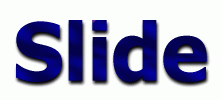|
Main
Resources
User's Guide
Administrator's Guide
HOW-TOs
Programmer's Corner
Slide API
Reference
|
| Introduction |
Slide includes an embedded distribution of Tomcat 4.0, configured as a
fully integrated content management system.
It is configured so that it provides multiple views of the data :
- Client view : Use web applications, browse information
- Editor view : Edit and configure web applications, modify
information
- Admin view : Manage users, define roles, administer the
server
|
| User's Guide |
The server resides in the "server" subdirectory in the Slide binary
distributions. The "server" directory conatins a specially configured
Tomcat 4 distribution, which is run exactly the same way Tomcat 4 is run.
The Tomcat 4 User's Guide provides more details on this.
The Slide domain is configured with the "conf/slide.xml" file which is
in the "server" directory, and it's mostly unchanged when compared to
the Domain.xml which is in a web application, except that :
- auto-create-users should always be set to false (it is false
by default)
- the default namespace should be set, and its value should be the
name of a valid namespace
The store definition and configuration is still unchanged.
The Tomcat 4 configuration file is still located in "conf/server.xml". It
can be edited to change the port numbers which will be used by
the connectors, among other things.
Contexts will be created using the namespaces which are defined in the
Slide domain. Additional details are given below.
| Client View |
The client view can be accessed (using the default configuration) on
port 8080.
The client view provides a standard Tomcat 4 environment, with the same
functionality as those normally provided by Tomcat 4, except without
the concept of virtual hosting, due to design decisions in Slide.
For each namespace defined in the Slide domain, a separate web
application context will be created in the servlet container. For
example, if the "foo" namespace is defined in Slide, then a "foo"
context will be created in Tomcat 4. A realm will be automatically
associated with that context, and will authenticate pricipals against
the principals defined in the Slide namespace.
Any web application which is designed so that it doesn't access the
files within its web application directory using direct filesystem
access should run without any modification (file access should be
replaced by calls like ServletContext.getResource, which abstract
filesystem access). This includes applications like Jasper, and any
web application written according to Sun's guidelines.
|
| Editor View |
The editor view can be accessed (using the default configuration) on
port 8081.
Note : For security reasons, the default configuration does not
have any user which can successfully be authenticated. To be able to
successfully authenticate a user, edit the Domain.xml file and set a
password for the user. An example is provided in the file for user
"/users/root".
Each namespace in the Slide doamin will be associated to a context,
which is fully managed by the Slide WebDAV servlet. Any WebDAV client
can be used to edit the contents of these contexts. A realm will be
automatically associated with that context, and will authenticate
pricipals against the principals defined in the Slide namespace.
All resources in the web application can be accessed and edited,
according to the permissions the authenticated principal has. This
includes class files, JSP sources, ... It is highly recommended that
if this setup is used in a publicly accessible computer, that the port
on which this host is running is hidden from the outside world, either
by configuring the connector to only accept requests from some IP
addresses, or (preferably) by using a firewall.
Since Slide is running in the background, all the services Slide
provides are used to manage the web applications. This includes a rich
ACL system, versioning, locking ...
|
| Admin View |
The first management component which is available is the Catalina
manager web application. It can be accessed in context "manager" on
port 8080 (it runs on the same host as the client view). The manager
requires an authenticated user with role "manager". This user is not
defined in any of the Slide managed realms, but instead is defined in
a memory based realm. The "conf/tomcat-users.xml" defines the users
of this realm. The manager sevlet provides an interface which can be
used to start/stop/reload contexts, view active sessions, ...
A Slide specific management application is provided on port 8082.
Again, this port should be restricted should the server be made
available as a public server on the internet. This interface is a work
in progress, and will allow to view and edit the configuration of the
namespaces, as well as manage principals.
|
|
| Administrator's Guide |
| Logging |
The standalone server provides multiple log files which are located in
the "logs" directory.
| Catalina Loggers |
- catalina_log: Catalina logger for the main view
- catalina_webdav_log: Catalina logger for the WebDAV view
- catalina_admin_log: Catalina logger for the admin view
- localhost_log: Logger of the default host for the main view
- localhost_access_log: Access log of the default host for the
main view
- webdav_log: Logger of the default host for the WebDAV view
- webdav_access_log: Access log of the default host for the
WebDAV view
- admin_log: Logger of the default host for the admin view
- admin_access_log: Access log of the default host for the
admin view
|
| Slide Loggers |
- slide_domain: Slide domain logger
- slide_ns_<name>: Logger for namespace <name>
|
|
|
|



